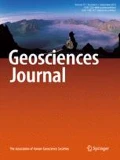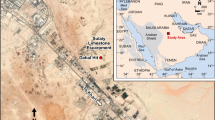Abstract
This studied rocks form part of the southern Hazara basin in the NW Himalayan Fold and Thrust belt, Pakistan. Thick inner to mid ramp carbonate platform deposits of Samana Suk Formation (Bajocian-Callovian) mostly composed of medium to thick bedded limestone with occasional dolostone beds are exposed in various localities. In the present studies, attempt has been made to understand degree of diagenetic alterations (i.e., dolomitization) within various limestone facies due to fluid-rock interaction phenomenon, and its impact on the reservoir behavior of altered rocks based on field investigations, petrographic studies, stable isotope signatures and porosity/permeability analysis. Field observations revealed various limestone types (oolitic, burrowed, fossiliferous, micritic and sandy), whereas dolomite occurs as completely replacive phase (Dol-I), and partially replacive patchy bodies (Dol-II) respectively. Petrographic studies showed various limestone and dolomite facies, which include: (i) Grainstone facies (bioclastic grainstone, peloidal grainstone, ooidal grainstone and pel-bioclastic grainstone), (ii) Packstone facies (bioclastic packstone and peloidal packstone), (iii) Wackestone facies (bioclastic wackestone), (iv) Mudstone facies (lime mudstone, and (v) Dolomite facies (coarse crystalline strata-bound Dol-I, and fine crystalline patchy Dol-II) respectively. O/C isotope analysis revealed that Dol-I shows signatures of δ18O (−5.84 to −3.91‰ V-PDB), and δ13C (+0.6 to +2.37‰ V-PDB) are within the limit of the carbonate marine seawater signatures, hence originated from sea-water or modified sea-water, whereas Dol-II exhibited depleted δ18O values (−6.88 to −5.87‰ V-PDB) and slightly depleted δ13C signatures (+0.968 to +1.85‰ V-PDB), indicating high temperature dolomitizing fluids. During early stage of marine diagenesis, which resulted in the cementation of pores within the grainstone-packstone facies, whereas mudstone-wackestone facies remained unaltered due to low porosity and permeability. Late stage dolomitization caused partial to complete alteration of mudstone-wackestone facies, in contrast grainstone-packstone facies are not affected by dolomitizing fluids due to the fact that the pore network of these coarser facies had already been occluded by the preceding marine cementation event. Porosity and permeability analyses revealed relatively high porosity values (4–8%) and permeability values (11.5 mD) in the dolomitized facies, whereas unaltered limestone facies showed considerably low porosity/permeability values (> 1%). In conclusion, less porous/permeable fine-grained facies evolved into more porous and permeable units due to the interaction of dolomitizing fluids of hydrothermal origin, which confirms that the original sedimentary texture of rock has implications on the selectivity of any diagenetic alteration.
Similar content being viewed by others
References
Ahmad, S., Ali, A., and Rehman, K., 2017, The interrelationship of micro-meso and macroscopic structures on the western limb of the Hazara Kashmir Syntaxis, Pakistan. Acta Geologica Sinica, 91, 1573–1623. https://doi.org/10.1111/1755-6724.13401
Ahsan, N. and Chaudhry, M.N., 2008, Geology of Hettangian to middle Eocene rocks of Hazara and Kashmir basins, northwest lesser Himalayas, Pakistan. Geological Bulletin of Punjab University, 43, 131–152.
Algive, L., Bekri, S., Nader, F.H., Lerat, O., and Vizika, O., 2012, Impact of diagenetic alterations on the petrophysical and multiphase flow properties of carbonate rocks using a reactive pore network modeling approach. Oil & Gas Science and Technology — Revue d’IFP Energies nouvelles, 67, 147–160.
Ali, F., Haneef, M., Anjum, M.N., Hanif, M., and Khan, S., 2013, Microfacies analysis and sequence stratigraphic modeling of the Samana Suk Formation, Chichali Nala, Trans Indus Ranges, Punjab, Pakistan. Journal of Himalayan Earth Sciences, 46, 41–53.
Al-Mojel, A., Dera, G., Razin, P., and Le Nindre, Y.M., 2018, Carbon and oxygen isotope stratigraphy of Jurassic platform carbonates from Saudi Arabia: implications for diagenesis, correlations and global paleoenvironmental changes. Palaeogeography, Palaeoclimatology, Palaeoecology, 511, 388–402. https://doi.org/10.1016/j.palaeo.2018.09.005
Al-Ramadan, K., Morad, S., and Plink-Björklund, P., 2013, Distribution of diagenetic alterations in relationship to depositional facies and sequence stratigraphy of a wave- and tide-dominated siliciclastic shoreline complex: Upper Cretaceous Chimney Rock Sandstones, Wyoming and Utah. In: Morad, S., Ketzer, J.M., and De Ros, L.F. (eds.), Linking Diagenesis to Sequence Stratigraphy. International Association of Sedimentologists Special Publication, Wiley, New Jersey, 45, p. 271–296.
Barbier, M., Hamon, Y., Callot, J.P., Floquet, M., and Daniel, J.M., 2012, Sedimentary and diagenetic controls on the multiscale fracturing pattern of a carbonate reservoir: The Madison Formation (Sheep Mountain, Wyoming, USA). Marine and Petroleum Geology, 29, 50–60.
Bathurst, R.G.C., 1986, Carbonate Sediments and Their Diagenesis (1st edition). Developments in Sedimentology, vol. 12, Elsevier, New York, 657 p.
Bender, F.K. and Raza, H.A., 1995, Geology of Pakistan. Gebrilder Borntraeger, Berlin, 441 p.
Chatalov, A., 2018, Origin of fabric selective dolomitization recognizable in the field: two case studies from Anisian carbonate rocks in the western Balkanides. Geologica Balcanica, 47, 43–60.
Cheema, A.H., 2011, Microfacies, diagenesis and depositional environments of Samana Suk Formation (Middle Jurassic) carbonates exposed in southeast Hazara and Samana Range. Ph.D. Thesis (Unpublished), University of the Punjab, Lahore, Pakistan, 259 p.
Craig, J., Hakhoo, N., Bhat, G.M., Hafiz, M., Khan, M.R., Misra, R., Pandita, S.K., Raina, B.K., Thurow, J., Thusu, B., Ahmed, W., and Khullar, S., 2018, Petroleum systems and hydrocarbon potential of the North-West Himalaya of India and Pakistan. Earth-Science Reviews, 187, 109–185. https://doi.org/10.1016/j.earscirev.2018.09.012
Dunham, R.J., 1962, Classification of carbonate rocks according to depositional textures. In: Ham, W.E. (ed.), Classification of Carbonate Rocks — A Symposium. AAPG Memoir, American Association of Petroleum Geologists, 1, p. 108–121.
Ehrenberg, S.N., Eberli, G.P., Keramati, M., and Moallemi, S.A., 2006, Porosity-permeability relationships in interlayered limestone-dolostone reservoir. American Association of Petroleum Geologists Bulletin, 90, 91–114.
Fatmi, A.N., Hyderi, I.H., and Anwar, M., 1990, Occurrence of the lower Jurassic Ammonoid Genus Bouleiceras from the Surghar Range with a revised nomenclature of the Mesozoic rocks of the Salt Range and Trans Indus Ranges (Upper Indus Basin). Geological Bulletin, Punjab University, 25, 38–46.
Flügel, E., 2010, Microfacies of Carbonate Rocks Analysis: Interpretation and Application. Springer, Berlin, 685 p.
Ghazanfar, M., Chaudhry, M.N., and Latif, M.A., 1987, Three stratigraphic provinces at Hazara Kashmir Boundary, Pakistan. Kashmir Journal of Geology, 5, 65–74.
Ghazanfar, M., Chaudhry, M.N., Pervaiz, K., Qayyum, M., and Ahmad, R., 1990, Geology and structure of Kuza Gali-Dunga Gali-Ayubia Area, Hazara-Potwar Basin with a Reference to Hydrocarbon Prospects of Attock-Hazara Fold and Thrust Belt. Pakistan Journal of Hydrocarbon Research, 2, 43–55.
Gingras, M.K., Pemberton, S.G., Muelenbachs, K., and Machel, H., 2004, Conceptual models for burrows-related, selective dolomitization with textural and isotopic evidence from the Tyndall Stone, Canada. Geobiology, 2, 21–31.
Hass, J., Budai, T., Gyori, O., and Kele, S., 2014, Multiphase partial and selective dolomitization of Carnian reef limestone (Transdanubian Range, Hungary). Sedimentology, 61, 836–859.
Hammer, E., Mork, M.B.E., and Næss, A., 2010, Facies controls on the distribution of diagenesis and compaction in fluvial-deltaic deposits. Marine and Petroleum Geology, 27, 1737–1751.
Hopkins, J.C., 2004, Geometry and origin of dolomudstone reservoirs: Pekisko Formation (Lower Carboniferous), Western Canada. In: Braithwaite, C.J.R., Rizzi, G., and Darke, G. (eds.), The Geometry and Petrogenesis of Dolomite Hydrocarbon Reservoirs. Geological Society, London, Special Publications, 235, p. 349–366.
Hussain, H.S., Fayaz, M., Haneef, M., Hanif, M., Jan, I.U., and Gul, B., 2013, Microfacies and diagenetic-fabric of the Samana Suk Formation at Harnoi Section, Abbottabad, Khyber Pakhtunkhwa, Pakistan. Journal of Himalayan Earth Sciences, 46, 79–91.
Janjuhah, H.T., Alansari, A., and Santha, P.R., 2019, Interrelationship between facies association, diagenetic alteration and reservoir properties evolution in the Middle Miocene carbonate build up, Central Luconia, Offshore Sarawak, Malaysia. Arabian Journal for Science and Engineering, 44, 341–356. https://doi.org/10.1007/s13369-018-3341-9
Kaufman, J., Harrison, G.N., and Meyers, W.J., 1991, Dolomitization of the Swan Hills Formation, Rosevear field, Alberta, Canada. Sedimentology, 38, 41–66.
Khan, M.S., 2015, Utilizing seismic and well logging techniques for locating hydrocarbon of Kabirwala area Punjab Platform Pakistan study area (Kabirwala). Journal of Environment and Earth Science, 5, 69–83.
Lucia, J.F., 1995, Rock-fabric/petrophysical classification of carbonate pore space for reservoir characterization. American Association of Petroleum Geologists Bulletin, 79, 1275–1300.
Masood, H., 1989, Samana Suk Formation depositional and diagenetic history. Kashmir Journal of Geology, 6, 151–161.
Moss, S.J. and Tucker, M.E., 1996, Dolomitization associated with transgressive surfaces — a mid-Cretaceous example. Sedimentary Geology, 107, 11–20. https://doi.org/10.1016/S0037-0738(96)00066-8
Mughal, M.A., Sarhan, A.G., Gilmour, E.H., and Rahman, U.O., 1981, Carbonate petrography and microfacies of a portion of the Samana Suk Formation, Kohat Range, Pakistan. Geological Bulletin, University of Peshawar, 14, 73–84.
Murray, R.C. and Lucia, F.J., 1967, Cause and control of dolomite distribution by rock selectivity. Geological Society of America Bulletin, 78, 21–36.
Nizami, A.R. and Sheikh, R.A., 2009a, Sedimentology of the middle Jurassic Samana Suk Formation, Makarwal section, Surghar Range, Trans Indus Ranges, Pakistan. Geological Bulletin, Punjab University, 44, 11–25.
Nizami, A.R. and Sheikh, R.A., 2009b, Microfacies analysis and diagenetic settings of the middle Jurassic Samana Suk Formation, Sheikh Badin Hill section, Trans Indus Ranges, Pakistan. Geological Bulletin, Punjab University, 44, 69–84.
Qureshi, M.A., Baig, S., and Munir, M.H., 1997, Reconnaissance micro-facies analysis of the upper Jurassic Samana Suk Formation, Northern Hazara Pakistan. Geological Bulletin, Punjab University, 31–32, 145–151.
Qureshi, M.K.A., Butt, A.A., and Ghazi, S., 2008, Shallow shelf sedimentation of the Jurassic Samana Suk Limestone, Kala Chitta Range, Lesser Himalayas, Pakistan. Geological Bulletin, Punjab University, 43, 1–14.
Rosenbaum, J. and Sheppard, S.M., 1986, An isotopic study of siderites, dolomites and ankerites at high temperatures. Geochimca et Cosmochimica Acta, 50, 1147–1150.
Saller, A.H., Lounsburry, K., and Birchard, M., 2001, Facies control on dolomitization and porosity in the Devonian Swan Hills Formation in the Rosevear area, west-central Alberta. Bulletin of Canadian Petroleum Geology, 49, 458–471.
Scholle, P.A. and Ulmer-Scholle, D.S. (eds.), 2003, A Color Guide to the Petrography of Carbonate Rocks: Grains, Textures, Porosity, Diagenesis. AAPG Memoir, American Association of Petroleum Geologists, 77, 460 p. https://doi.org/10.1306/M77973
Shah, M.M., Haq, I.U., Ahmed, W., and Khan, N.R., 2014, Fault-related dolomite in the Kawagarh Formation (Turonian) and Samana Suk Formation (Callovian) in the Margalla Hill Ranges (N. Pakistan): implication on reservoir characterization. AAPG European Region Conference on Mesozoic and Cenozoic Carbonates of the Neo-Tethys: Old and New Concepts for Petroleum Exploration, Naples, Italy, Mar. 25–26, p. 154.
Shah, M.M., Ahmed, W., Ahsan, N., and Lisa, M., 2016, Fault-controlled, bedding parallel dolomite in the middle Jurassic Samana Suk Formation in Margalla Hill Ranges, Khanpur area (North Pakistan): petrography, geochemistry, and petrophysical characteristics. Arabian Journal of Geosciences, 9, 1–18.
Sheikh, R.A., Qureshi, M.K.A., Ghazi, S., and Masood, K.R., 2001, Jurassic carbonate shelf deposition Abbottabad District Northern Pakistan. Geological Bulletin, Punjab University, 36, 49–62.
Tucker, M.E. and Wright, V.P., 1990, Carbonate Sedimentology. Blackwell Scientific Publications, Oxford, 482 p. https://doi.org/10.1002/9781444314175
Umar, M., Sabir, M.A., Farooq, M., Khan, M.S., Faridullah, F., Jadoon, U.K., and Khan, A.S., 2015, Stratigraphic and sedimentological attributes in Hazara Basin Lesser Himalaya, North Pakistan: their role in deciphering minerals potential. Arabian Journal of Geosciences, 8, 1653–1667. https://doi.org/10.1007/s12517-014-1322-1
Vandeginste, V., Swennen, R., Reed, M.H., Ellam, R.M., Osadetz, K., and Roure, F., 2009, Host rock dolomitization and secondary porosity development in the Upper Devonian Cairn Formation of the Fairholme carbonate complex (South-west Alberta, Canadian Rockies): diagenesis and geochemical modelling. Sedimentology, 56, 2044–2060.
Widodo, R.W. and Laya, J.C., 2017, Controls on diagenesis and dolomitization of peritidal facies, early Cretaceous Lower Edwards Group, Central Texas, USA. Facies, 63, 23. https://doi.org/10.1007/s10347-017-0503-2
Wilson, J.L., 1975, Carbonate Facies in Geological History. Springer, New York, 471 p.
Zahid, M., Ahmad, S., Ali, F., and Rehman, G., 2009, Structural geometry of a part of the southeastern Hazara Fold-Thrust Belt, Khyber Pakhtunkhwa, Pakistan. Pakistan Journal of Hydrocarbon Research, 19, 19–28.
Acknowledgments
The authors are highly indebted to Geology & Reservoir Labs, Oil and Gas Development Company Limited for porosity permeability analysis. In addition, we are thankful to Institute of Geological Sciences, Jagiellonian University Krakow for cathodoluminescence microscopy.
Author information
Authors and Affiliations
Corresponding author
Additional information
Publisher’s Note Springer Nature remains neutral with regard to jurisdictional claims in published maps and institutional affiliations.
Rights and permissions
About this article
Cite this article
Shah, M.M., Rahim, H.U., Hassan, A. et al. Facies control on selective dolomitization and its impact on reservoir heterogeneities in the Samana Suk Formation (middle Jurassic), Southern Hazara Basin (NW Himalaya, Pakistan): an outcrop analogue. Geosci J 24, 295–314 (2020). https://doi.org/10.1007/s12303-019-0026-7
Received:
Accepted:
Published:
Issue Date:
DOI: https://doi.org/10.1007/s12303-019-0026-7




